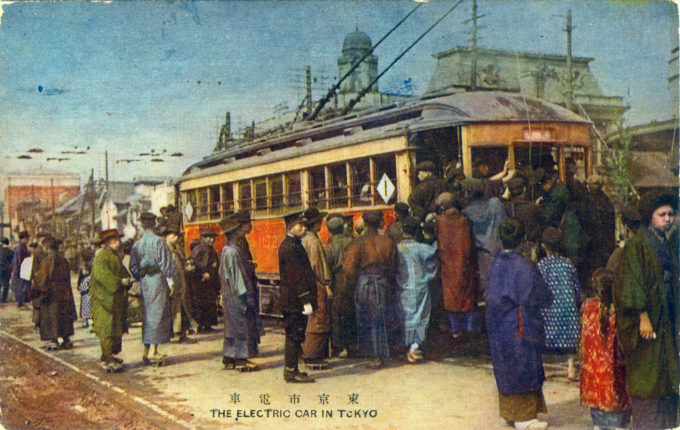See also:
Horse-drawn trolley, Nihonbashi, c. 1900
Ginza Crossing streetcars, c. 1960
“The first streetcars, referred to as a ‘horse trolleys without the horse’ (uma no nai basha), could hold up to forty people, sixteen seated and the rest standing. Like trains, they were rickety and made of wood. They had ten spaces for windows on both sides, poles for passengers to grasp for stability, and interior lights. Service started at 6:00 a.m. (5:00 a.m. Ginza) and lasted up until 1:00 a.m., and male transport workers were stationed at each stop to help control the crowds that gathered.
“All of the former horse-bus routes were electrified by 1904, and streetcar service was extended throughout the center of the city, connecting Shimbashi Station and such flourishing entertainment and commercials areas such as Ginza, Ueno Park, and Asakusa.
“… [T]hree streetcar companies – Tokyo densha tetsudo, Tokyo shigai tetsudo (nicknamed ‘Gaitetsu’), and Tokyo denki tetsudo (better known as the Sotobori line) – provided a network of trams that wove through the center of Tokyo. Each company’s streetcars were painted a different color … For example, Gaitetsu cars, which served areas as far west as Shinjuku, were green … The Sotobori streetcars had large glass-plate windows, luxuries many people had not seen before.
“These lines were consolidated into the Tokyo Railway Company (Tokyo tetsudo kaisah) on September 11, 1906, the year the nationalization of railways became law … Reasons for the streetcar merger included the public’s confusion about routes and the need to standardize schedules.”
– Tokyo in Transit: Japanese Culture on the Rails and Road, by Alisa Freedman, 2011

Map: Streetcar (in red), subway (Ueno Station-Asakusa, hashed-red line), and commuter trains (in blue); Tokyo, c. 1930. (For reference, the Imperial Palace is at center.)
“There are 110 miles of electric trams actually opened in the city of Tokyo and, according to the Company’s charter, 217 miles ought to be opened by the fall of this year [1910].
“The Company’s charter provides that, unless natural calamities or other unavoidable reasons present themselves, the whole system of lines must be completed by December of the 43rd year of Meiji [1910], and that failure to comply with this provision shall invalidate the charter. This question is now said to be under consideration. The Government must feel that its own refusal to allow the Company to charge a reasonable fare is alone responsible for the delay. On the other hand, the Company’s legal obligation is explicit.
“No one predicts what exit will be found from the dilemma.”
– The Japan Daily Mail, July 2, 1910

Electric streetcar glides across Shimbashi, c. 1905. Route #1, from Shinagawa-to-Ueno via Shimbashi & Ginza, was the first streetcar route to be completely electrified.
“Owasure mom nai yo ni negaima – ‘Let there be no honorable forget things, I pray,’ or ‘I beg your honor will not leave anything behind.’ Then ‘Now, the car is starting – kindly take care at this turning – she will sway.’ ‘Does anybody else wish to depart at this junction?’
“Under the manifold uncomfortable circumstances of a street railway system, ever inadequate, the conductor – in duplicate on each car, for some reason – exerts only an emollient effect. He is a saint among men. For long hours, he patiently endures being trampled on, being squeezed in crushes that threaten to pulp him – for hours he gently requests the crowd move to the center of the car.
“‘There are many passengers to enter the car – kindly do not crowd the doorway – please move your honorable self to fill up the vacant space in center of car.’ The crowd remains a wall. Times without number he hops into the window of the platform to make space for one more passenger.
“His uniform may be frayed at the seams; his peaked cap may be worn to the lining; his shoes may be torn, and his fingers peep through his gloves – but his good temper is eternal. Under circumstances that would brutalize an angel he carries on with dauntless good nature.”
– “In Tokyo Thoroughfares with Everyday Folk”, by Edith de Garis, Japan: Overseas Travel Magazine, October 1930

Map: Streetcar, Tokyo, c. 1940. (For reference, the Imperial Palace is at center.) At its peak in the 1930s, the Toden system boasted 41 routes with 213 kilometers of track. In the aftermath of the 1923 Great Kanto Earthquake, city planners had already begun to place more emphasis on vehicular bus service (principally because of the expensive repairs to track and tram wires needed after the earthquake). And, in the postwar era, the increase in automobile traffic resulted in steep reductions in ridership. From 1967 to 1972, 181 km of track were abandoned.
- Streetcar, Tokyo, c. 1920.
- Streetcar, Tokyo, c. 1920.






